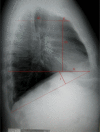Upper third to lower third width ratio on chest x-ray may predict severity of obstruction in obstructive lung disease
- PMID: 25191489
- PMCID: PMC4153277
Upper third to lower third width ratio on chest x-ray may predict severity of obstruction in obstructive lung disease
Abstract
Background: The symptoms and functional limitations due to obstructive lung disease (OLD) are the direct results of airway and lung parenchymal destruction. In these conditions, airflow obstruction leads to increased work of breathing, and gas exchange abnormalities. Hyperinflation, which is inferred from a standard chest radiograph (CXR), may imply increased total lung capacity that can be seen in patients with OLD. Based on experimental observations in OLD patients, we proposed that upper third width in posterioranterior (PA) CXR could be used as a rapid screening method for suggestion of OLD.
Materials and methods: In this cross-sectional study, 99 patients admitted to the Respiratory Ward of Razi Medical Center, a teaching referral hospital affiliated to Guilan University of Medical Sciences (GUMS), were entered in the study. The inclusion criteria were any FEV1 with FEV1/FVC <70% or FEV1/FVC>70% with MMEF 75/25 <65%. All cases with diagnostic possibilities other than OLD were excluded. The PA and lateral CXR were performed and 13 measurements - including previous well-known measurements and our proposed new ones- were made by an ordinary ruler on the films.
Results: There was no significant correlation between the upper third width and superior/inferior (sup/inf) ratio with spirometric indices in patients. When considering only patients with FEV1/FVC <70%, middle third proportion width had a significant correlation with FEV1/FVC. In subgroup analysis when considering sup/inf ratio > 0.8, superior and inferior third widths were correlated with FEV1/FVC and when considering sup/inf ratio > 0.9, sup/inf ratio was significantly correlated with FEV1/FVC and FEV1.
Conclusion: The sup/inf ratio >0.9 in PA CXR, may be a predictor of obstructive pattern in OLD patients. For better correlation determination, larger and more extensive studies are needed.
Keywords: Chest X-Ray; Obstructive Lung Disease; Severity.
Figures
Similar articles
-
Correlation of the Ratio of Upper Third to Lower Third Circumferences of the Chest with Obstructive Pattern in Spirometry.Tanaffos. 2015;14(4):222-6. Tanaffos. 2015. PMID: 27114722 Free PMC article.
-
A Simple Measure to Assess Hyperinflation and Air Trapping: 1-Forced Expiratory Volume in Three Second / Forced Vital Capacity.Balkan Med J. 2017 Apr 5;34(2):113-118. doi: 10.4274/balkanmedj.2015.0857. Balkan Med J. 2017. PMID: 28418337 Free PMC article.
-
Comparison of Forced and Slow Vital Capacity Maneuvers in Defining Airway Obstruction.Respir Care. 2019 Jul;64(7):786-792. doi: 10.4187/respcare.06419. Epub 2019 Mar 19. Respir Care. 2019. PMID: 30890630
-
Importance of slow vital capacity in the detection of airway obstruction.J Bras Pneumol. 2013 May-Jun;39(3):317-22. doi: 10.1590/S1806-37132013000300008. J Bras Pneumol. 2013. PMID: 23857701 Free PMC article.
-
Lower limit of normal or FEV1/FVC < 0.70 in diagnosing COPD: an evidence-based review.Respir Med. 2011 Jun;105(6):907-15. doi: 10.1016/j.rmed.2011.01.008. Epub 2011 Feb 5. Respir Med. 2011. PMID: 21295958 Review.
Cited by
-
Correlation of the Ratio of Upper Third to Lower Third Circumferences of the Chest with Obstructive Pattern in Spirometry.Tanaffos. 2015;14(4):222-6. Tanaffos. 2015. PMID: 27114722 Free PMC article.
References
-
- Steven D Shapiro, John J Reily, Jr, Stephen I Rennard. Murray and Nadels Text book of respiratory medicine. 5th edition. United states of America: 2010. Chronic bronchitis and emphysema; pp. 919–921.
-
- Peter Armstrong, Martin L. Wastie. Fourth edition. Blackwell publishing ltd; 1998. Diagnostic Imaging; p. 754.
-
- Robert J. Mason. In: V. Murray and Nadel's Textbook of Respiratory Medicine: 2-Volume Set. 4th edition. Broaddus V. Courtney, Murray John F, Nadel Jay A., editors. Saunders; 2005. pp. 131–132.
-
- Fraser Richard S, Colman Neil, Muller Nestor L, Pare PD. Third edition. Saunders; 2005. Synopsis of diseases of the chest; pp. 131–132.
-
- Rennard SI. Chronic obstructive pulmonary disease: Definition, clinical manifestations, diagnosis, and staging; UpToDate version 17.1: January 2009
LinkOut - more resources
Full Text Sources


